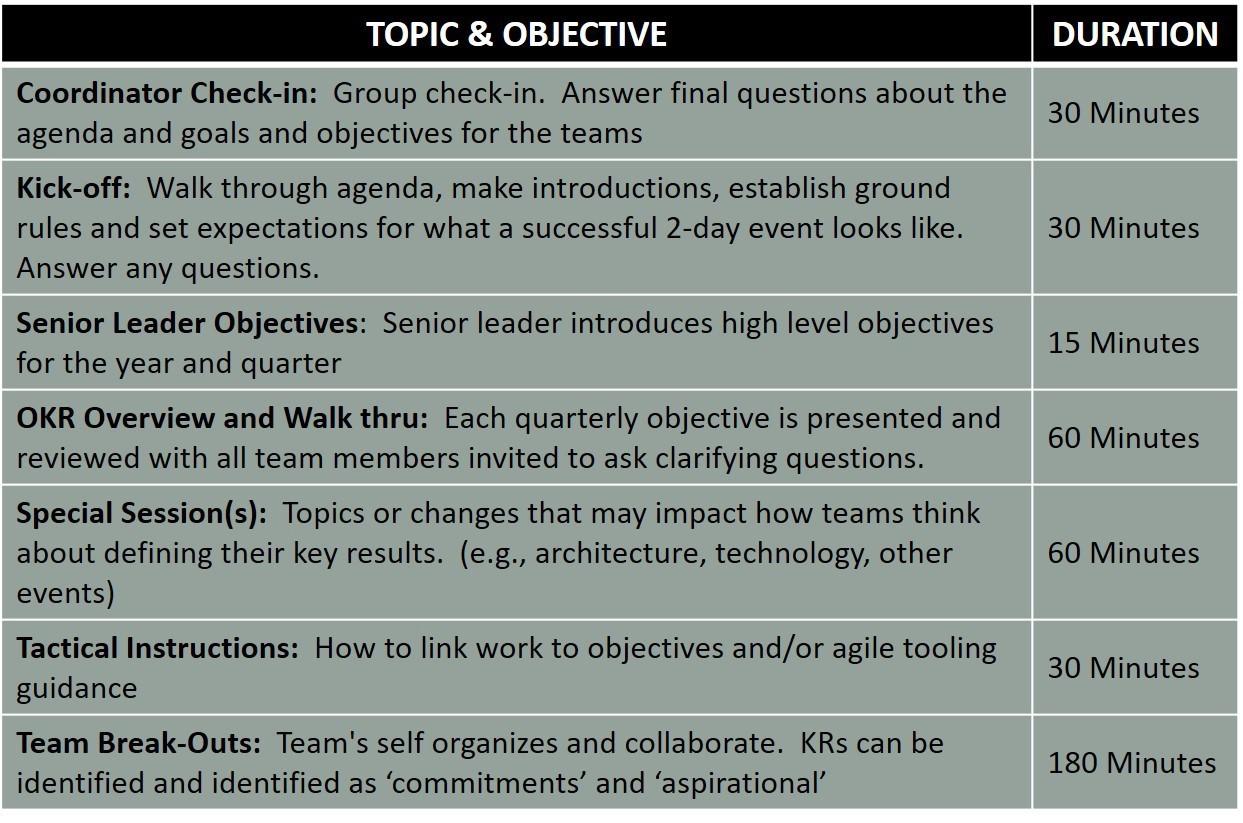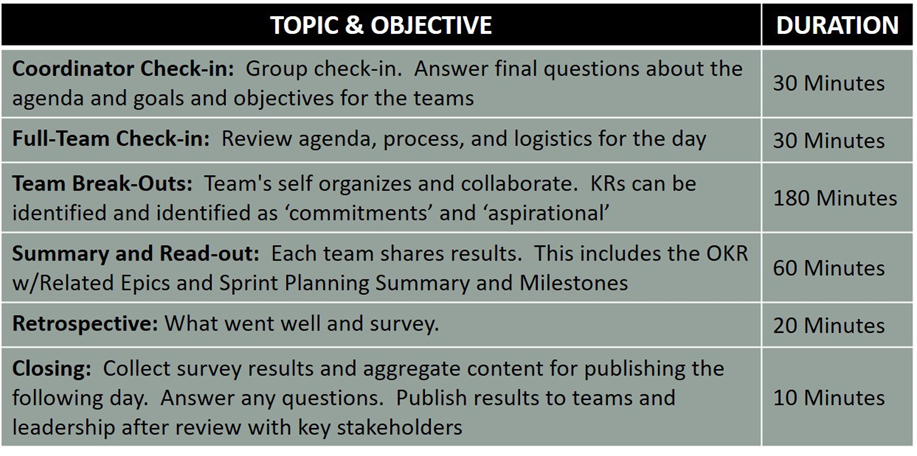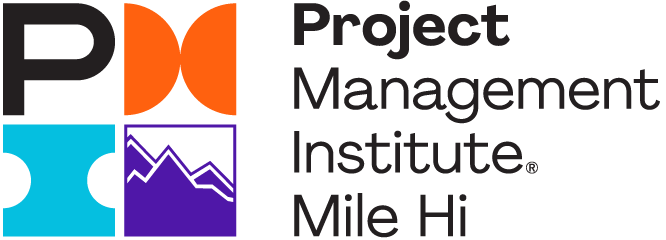22 April 2021 at 11:00PM
6 Steps to OKR Event Orchestration (Part 2)
When teams receive prioritized assignments from leadership, their effectiveness improves. To the high-performing team, few scenarios excite them more than having a clear direction and autonomy to act.
Part 1 of this blog series describes the benefits of the OKR framework and provides 2 of the 6 steps to successful OKR event orchestration. This blog post starts with Step 3.
Step 3: Pre-planning Is the Fulcrum of the Quarterly Event
After leadership establishes organizational priorities, project managers can engage teams. Many organizations adopt quarterly OKRs and introduce a planning cadence. This frequency provides time for both planning and executing. Success begins with a pre-ceremony period I have termed "pre-planning."
Any work required to help teams prepare for the quarterly planning ceremony falls into this grouping. Having clear goals articulated and understood by senior leadership and teams before the event is crucial.

Image created by the author
If you believe in the Pareto principle, pre-planning becomes your 20%. Spending a small amount of time on the most important activity will dramatically influence your results. Without preparing the way for your team(s) and key influencers, expect failure. You will need help across the organization before performing the planning event. Areas to concentrate on most include influencers, organizational goals, calendar, and communication.
- Meet with influencers:
Influencers at every level can make or break any change you seek to make. Learn who they are, meet with them, and listen to their concerns. If a positional leader can help, ask for it. For some, helping might be listening to your plan. For others, it might be to get hands-on and co-coordinate the event. Knowing you have their support early on will not only give you confidence but also give you the positional leverage needed to move some less inclined to help. For influencers who are less supportive, you should listen to them too, because they may provide the helpful insight you need to improve preparations. Potentially, you might win them over if you can find common ground. If not, you know the topics to follow-up on with other supportive members or leadership. The goal is to move the team forward and align strategically with the organization. While meeting with influencers, identify who on each team can help you in the orchestration to drive alignment across all participants. Suggestion: Continue to meet informally with your key influencers because they may have new ideas to help increase buy-in across the organization. - Focus on organizational goals:
Work diligently to receive goals from both the leadership and teams separately. Team goals and roadmaps may already be published and easier to retrieve. Teams will expect senior leaders to share their goals, too, because most team members have experienced a last-minute change in direction that blows up a great plan. When you are reviewing various perspectives, expect differences. Minor changes can typically be tied up with a discussion and some wordsmithing to align teams. Reconciling material variances might take longer. Allow enough time for decision-makers and team leads to agree on what success looks like. The best collaboration results in clear and achievable key results. Suggestion: Pay attention to senior leadership communications; if something is changing, bring it to team leadership to ensure planning remains aligned. - Calendar:
Communicating to meet the needs of the team members is our responsibility so that they can be successful, even if doing so takes more of our time. Develop and publish a calendar of activities; highlight what teams should expect. Use multiple channels, such as team calendar, organizational calendar, e-mail, and collaboration space. The benefit of a public calendar is that it reduces the chances of surprising team members. Leaders with full schedules will appreciate reminders. Their teams will need several hours over several weeks to be fully prepared. Providing them a calendar is a key ingredient to their success. Suggestion: Identify the event day and work backward. Begin pre-planning at least 6 weeks before the event day. - Team Communication:
Do more than just provide the dates; describe what the teams should be doing. For example, you might suggest reconciling their current plans to new leadership objectives. This helps by reducing surprises. When team leaders discuss possible changes coming, team members can help avoid serious problems and delays. Encourage team leaders to frame the work they are performing in terms of how they are achieving the objective. Showing the connection between work and leadership priorities can help people feel they are making a difference. Leading up to the event, begin meeting with an individual of each team who will aid in the orchestration activities during the event (typically a team lead, project manager, or scrum master). Suggestion: Send the same messages through multiple channels on a predictable cadence.
Step 4: Planning the Quarterly Event
When you have the right people helping and clear objectives, orchestrating the event is simplified.
For a 2-day event (in-person or virtual), the way you spend time will be similar, but the logistics are different. Build a pre-event checklist, and walk through the following topics with your key influencers and team leaders.
Quarterly planning checklist topics:
- Propose event dates: Review dates with the leadership and key influencers. Avoid dates around holidays, and if you can, avoid Mondays and Fridays.
- Identify participants: Ensure decision-makers and key members are all identified.
- Choose a venue: If virtual, most video conferencing now has break-out rooms if needed to facilitate small group sessions. If in-person, select a location that inspires creativity and has room for an all-hands gathering as well as break-out areas for teams to meet.
- Publish dates: Do this once dates have been established; publish at least 3 weeks before the event for virtual; provide more advance notice for an in-person event.
- Duration of the work: These will be full days. Be sensitive to the organizational culture and how teams work together. Remember more time does not equate to more productivity.
- Send invites: Send out invitations to the 2-day event. Query your influencers to review the list so that you don’t miss key individuals.
- Solicit content: Ask team leaders what they think should be included that will help teams achieve objectives. Work deliberately to bring the right content to the participants. Every minute is precious.
- Secure materials: During an in-person event, have all the necessary materials in the room and test the equipment.
- Organize content: Prioritize content that influences the design or thinking about architecture or solutions to be developed.
- Develop a survey: Ensure you have a survey ready to go during the last session of day 2 so that feedback is received immediately and can be shared.
This list is not comprehensive but is a good start in developing your logistical checklist to be sure everything is in place. The goal here is to create a safe environment for teams to do the work. Ensuring the logistics are well-managed takes the pressure off of team members. They will thank you when they recognize how smooth the event ran because of the thoughtful planning.
Step 5: Orchestrating the Event
The goal for the morning is to ensure clear articulation of the quarterly objectives and the importance of each contributor.
The importance of hearing directly from the organizational leaders cannot be underestimated. Not only does it remove ambiguity, but it also introduces a higher level of accountability to both leaders and their teams. You might even choose to record the session if some key individuals are unable to attend so that they can hear the conversation for themselves.
Following the morning session, teams break out. For self-organizing teams, this will be easier, although some guidance may still be required. During pre-planning time, we identified event coordinators on each team. This is when they can shine and use their influence in helping their teams complete the event goals.
For organizations requiring more help, additional planning can be performed before the event. Specific sessions, times, topics, and agendas can be developed. If needed, a facilitator can help at the team level to time-box topics and ensure they are successful. What follows is my day 1 agenda with topics and descriptions.
Day 1 agenda

Image created by the author
Day 2 continues with teams continuing to work together--on their terms. Experience shows teams know best how to achieve results. Giving them as much time as possible to do their work is important. A short meeting to align and ask questions starts the day to maintain alignment.
After lunch, the teams will be expected to share their outcomes. The summary will include the key results and how they will measure them. They may also identify important milestones that will occur throughout the quarter. These are especially important to senior leaders who want to have a sense of how the team is doing along the way. Having publishable milestones and a way to measure progress demonstrates the team did their job. When a team has developed their plan and mechanism to measure, they are more likely to achieve it.
After each team presents how they intend to deliver on the quarterly objectives, you begin evaluating the event. Survey during the presentation time so that results are compiled within 2 hours works best. Then a summary and aggregation of the results can be shared with the teams and leadership right away. See the day 2 agenda below.
Day 2

Image created by the author
Step 6: Closing and Evaluating the Event
Closing the event deserves attention too. It bookends work performed over the past 6–8 weeks leading up to the event. What follows will give you a good start on ending your event on a positive note while maximizing the work teams have accomplished. When done right, this ritual will make the subsequent event easier!
Considerations to end the event well:
- Ask for verbal feedback: Do this throughout the event, but afterward too. As much as you can listen, listen, listen.
- Conduct a survey or poll: This will provide you with objective data that is sharable with teams and senior leadership. Use the same format each time and now you have a powerful time-series.
- Establish regular check-ins: Schedule meetings with key team members. Keep your key influencers informed on progress. If you have a tool to reflect how teams are executing, all the better. If not, have each team walk through how they are progressing using the measure they identified during the event.
- Publish dates: Schedule the next event to aid in team planning.
- Incorporate lessons learned: Work the findings into the next event.
- Write it down: Develop asummary and include survey results and share with leadership. Writing this can be a good aid to teach newer members of the team what was accomplished and how the team is working.
- Send recognition: Reward to those who helped you most. If your firm has a formal way of doing this, use it. If not, an e-mail to them with a cc to their manager can show your appreciation. Highlight what they specifically did that helped.
- Schedule follow-ups: Meet with teams that need your help. Some will.
- Share what you learn: Share with other teams and organizations in your firm or even outside if you have an opportunity. We can all get better. Sharing also brings new ideas and partners.
Last thoughts:
Performing quarterly planning offers many benefits to the organization, including increased focus leading to better results. Teams are energized when they understand how the work they do contribute to the success of the firm. A well-orchestrated quarterly planning session provides the organization a pathway to superior results.
References for this Blog Series
- Doerr, John E. 2018. Measure What Matters. London: Penguin.
- Doerr, John E. https://www.whatmatters.com.
- Niven, Paul R., and Ben Lamorte. 2016. Objectives and Key Results: Driving Focus, Alignment, and Engagement with OKRs. Hoboken: Wiley.
- McChesney, Chris, Sean Covey, and Jim Huling. 2012. The 4 Disciplines of Execution. Glencoe: Free Press.
Additional Resources
Interested in learning more about topics like this one? Check out upcoming events on our chapter calendar. Sign up for one of our upcoming meetings, roundtables, or workshops – a selection of which are virtual. Earn your PDUs through PMI Mile Hi Chapter!
About the Author
Eric Peterson is a creator, coach and servant leader. He writes about leadership, team building, and community. You can find more about him and his work through his website: Shepherd Leadership (shepherdingheart.com).



